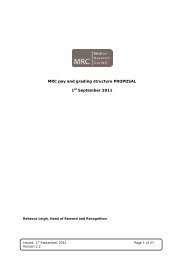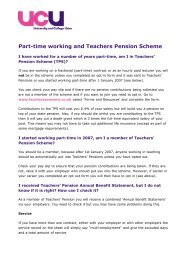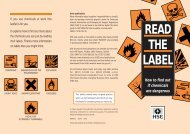n Managerial support reflects supportive behaviours from l<strong>in</strong>e managers<strong>and</strong> the organisation itself, such as availability <strong>of</strong> feedback <strong>and</strong>encouragement;n Relationships assesses levels <strong>of</strong> conflict with<strong>in</strong> the workplace <strong>in</strong>clud<strong>in</strong>gbully<strong>in</strong>g behaviour <strong>and</strong> harassment;n Role exam<strong>in</strong>es levels <strong>of</strong> role clarity <strong>and</strong> the extent to which employeesbelieve that their work fits <strong>in</strong>to the overall aims <strong>of</strong> the organisation;n Change reflects how <strong>well</strong> organisational changes are managed <strong>and</strong>communicated.The HSE risk assessment approach is widely utilised by <strong>in</strong>dividualorganisations, occupational groups <strong>and</strong> sectors to diagnose the most <strong>stress</strong>fulaspects <strong>of</strong> work. The process allows employers to assess how <strong>well</strong> they aremanag<strong>in</strong>g the different hazard categories with<strong>in</strong> their workforce, <strong>and</strong> helpsthem develop precisely targeted <strong>in</strong>terventions to enhance the work-related <strong>well</strong><strong>be<strong>in</strong>g</strong><strong>of</strong> their <strong>staff</strong>. The HSE provides normative data from a range <strong>of</strong>occupational groups, enabl<strong>in</strong>g employers to compare their scores for each <strong>of</strong>the hazards aga<strong>in</strong>st these national benchmarks. Where scores for any <strong>of</strong> thehazards are compared unfavourably, the HSE suggests <strong>in</strong>terim <strong>and</strong> longer-termtarget scores to help organisations improve their performance.The HSE process is recommended by the University <strong>and</strong> Colleges EmployersAssociation as an effective way <strong>of</strong> manag<strong>in</strong>g work-related <strong>stress</strong> (UCEA, nd). Agrow<strong>in</strong>g number <strong>of</strong> colleges <strong>and</strong> universities have adopted this approach toconduct <strong>in</strong>dependent <strong>survey</strong>s to assess the <strong>well</strong>-<strong>be<strong>in</strong>g</strong> <strong>of</strong> their employees, withsome success. In 2008, the University <strong>and</strong> College Union utilised the HSEmethod <strong>in</strong> a large-scale national <strong>survey</strong> <strong>of</strong> members <strong>in</strong> academic <strong>and</strong>academic-related roles (n = 14,270). F<strong>in</strong>d<strong>in</strong>gs revealed that people work<strong>in</strong>g <strong>in</strong><strong>higher</strong>, further <strong>and</strong> prison education reported lower <strong>well</strong>-<strong>be<strong>in</strong>g</strong> than the averagefor the HSE’s target <strong>in</strong>dustries, <strong>in</strong>clud<strong>in</strong>g the education sector (Court & K<strong>in</strong>man,2009a, 2009b, 2009c). Some key differences were found between sectors. Thebiggest ‘<strong>well</strong>-<strong>be<strong>in</strong>g</strong> gap’ <strong>in</strong> <strong>higher</strong> education was <strong>in</strong> the area <strong>of</strong> change, followedby role, then equally dem<strong>and</strong>s <strong>and</strong> managerial support.More positively, however, levels <strong>of</strong> control <strong>in</strong> <strong>higher</strong> education exceeded them<strong>in</strong>imum level suggested by the HSE. For members <strong>in</strong> further <strong>and</strong> adulteducation, the biggest <strong>well</strong>-<strong>be<strong>in</strong>g</strong> gap was <strong>in</strong> the area <strong>of</strong> change, followed bydem<strong>and</strong>s, then role <strong>and</strong> managerial support. For <strong>UCU</strong> members <strong>in</strong> prisoneducation, the widest gaps were <strong>in</strong> change, relationships <strong>and</strong> managementsupport. Unlike members from <strong>higher</strong> education, however, levels <strong>of</strong> controlreported by respondents from further, adult <strong>and</strong> prison education failed to meetthe HSE m<strong>in</strong>imum level.A high proportion <strong>of</strong> the sample from the 2008 <strong>survey</strong> as a whole consideredtheir job to be <strong>stress</strong>ful. Around half reported their general or average level <strong>of</strong><strong>stress</strong> to be high or very high, <strong>and</strong> approximately one-third said they <strong>of</strong>tenexperienced levels <strong>of</strong> <strong>stress</strong> they found unacceptable. The <strong>survey</strong> also<strong>in</strong>vestigated the work<strong>in</strong>g conditions <strong>and</strong> job characteristics that wereconsidered to make the highest contribution to <strong>stress</strong> or frustration <strong>among</strong>st8
<strong>UCU</strong> members. Respondents from <strong>higher</strong> education <strong>in</strong>dicated that lack <strong>of</strong> timeto undertake research, followed by excessive workload <strong>and</strong> lack <strong>of</strong> resources toundertake research were the most <strong>stress</strong>ful factors. In further <strong>and</strong> adulteducation, the factors considered to be most <strong>stress</strong>ful were excessiveworkloads, opportunities to develop teach<strong>in</strong>g, <strong>and</strong> lack <strong>of</strong> time for research. Themost frequent responses from respondents <strong>in</strong> prison education related to lack<strong>of</strong> resources to undertake research (<strong>in</strong>clud<strong>in</strong>g problems <strong>in</strong> obta<strong>in</strong><strong>in</strong>g fund<strong>in</strong>g),lack <strong>of</strong> time or opportunities to develop teach<strong>in</strong>g, excessive workloads <strong>and</strong> poorwork-life balance. Similar f<strong>in</strong>d<strong>in</strong>gs emerged from a smaller-scale <strong>survey</strong> <strong>of</strong> <strong>UCU</strong>members conducted <strong>in</strong> 2010 (n = 720), but responses from members <strong>in</strong> prisoneducation were not sufficient to analyse <strong>in</strong>dependently (K<strong>in</strong>man, G., 2011).The <strong>UCU</strong> 2012 <strong>survey</strong><strong>of</strong> occupational <strong>stress</strong>:aims <strong>and</strong> methodThe 2012 <strong>survey</strong> aimed to exam<strong>in</strong>e the extent to which <strong>higher</strong> education<strong>in</strong>stitutions, further education colleges, adult education <strong>in</strong>stitutions <strong>and</strong> prisoneducation departments <strong>in</strong> the UK were meet<strong>in</strong>g the m<strong>in</strong>imum st<strong>and</strong>ardsstipulated by the HSE for the management <strong>of</strong> work-related <strong>stress</strong>. Mean scoreswere calculated across all seven <strong>of</strong> the hazard categories, with <strong>higher</strong> scoresrepresent<strong>in</strong>g more <strong>well</strong>-<strong>be<strong>in</strong>g</strong> <strong>and</strong> lower scores denot<strong>in</strong>g more di<strong>stress</strong> relat<strong>in</strong>gto each dimension. Comparisons were made between the mean scoresobta<strong>in</strong>ed <strong>in</strong> this <strong>survey</strong> for each hazard with the target <strong>in</strong>dustries, <strong>in</strong>clud<strong>in</strong>geducation, that were selected by the HSE because they had the ‘highest rates<strong>of</strong> work <strong>stress</strong>-related ill-health <strong>and</strong> absence’ (Webster & Buckley, 2008, p. i). 2Where mean scores for any hazards are compared unfavourably withbenchmarks, recommendations for improvement are provided <strong>in</strong> terms <strong>of</strong>: a)<strong>in</strong>terim targets (over the next six to 12 month period) based on the 50thpercentile figures <strong>and</strong> b) longer term target scores obta<strong>in</strong>ed from the 80thpercentile figures.The first 35 items <strong>in</strong> the <strong>survey</strong> questionnaire (see Appendix) were from theHSE’s Management St<strong>and</strong>ards Indicator Tool. In addition to the HSE questions,this <strong>survey</strong> exam<strong>in</strong>ed levels <strong>of</strong> perceived <strong>stress</strong> <strong>and</strong> work<strong>in</strong>g hours, <strong>and</strong>compared f<strong>in</strong>d<strong>in</strong>gs with those from several <strong>UCU</strong> <strong>survey</strong>s conducted over the lastdecade. The extent <strong>of</strong> work-life conflict experienced by <strong>UCU</strong> members wasexam<strong>in</strong>ed us<strong>in</strong>g a questionnaire developed by Fisher et al. (2009). In order toassess the extent <strong>of</strong> <strong>in</strong>tegration between work <strong>and</strong> home life, respondentswere asked to <strong>in</strong>dicate on a n<strong>in</strong>e-po<strong>in</strong>t scale (where 1 denoted total separation<strong>and</strong> 9 represented total <strong>in</strong>tegration) the follow<strong>in</strong>g: a) the extent to which theirwork <strong>and</strong> home lives were separated/<strong>in</strong>tegrated <strong>and</strong> b) the extent to which theywished their work <strong>and</strong> home lives to be separated/<strong>in</strong>tegrated. The degree <strong>of</strong> fitbetween the level <strong>of</strong> <strong>in</strong>tegration currently experienced <strong>and</strong> that which is desiredwas then calculated.2 These target <strong>in</strong>dustry averages were notupdated <strong>in</strong> the 2009 HSE report.Work<strong>in</strong>g conditions <strong>and</strong> job characteristics differ considerably between <strong>higher</strong>,further, adult <strong>and</strong> prison education. This is reflected <strong>in</strong> the f<strong>in</strong>d<strong>in</strong>gs <strong>of</strong> previous<strong>survey</strong>s <strong>of</strong> <strong>UCU</strong> members reported above, where the HSE hazard categorieswith the biggest <strong>well</strong>-<strong>be<strong>in</strong>g</strong> gap <strong>and</strong> the features <strong>of</strong> work that are consideredmost <strong>stress</strong>ful were found to vary. Accord<strong>in</strong>gly, separate analyses have beenconducted for <strong>higher</strong>, further, adult <strong>and</strong> prison education <strong>and</strong> data is presented<strong>in</strong> separate reports. Where appropriate, comparisons have been made on levels9


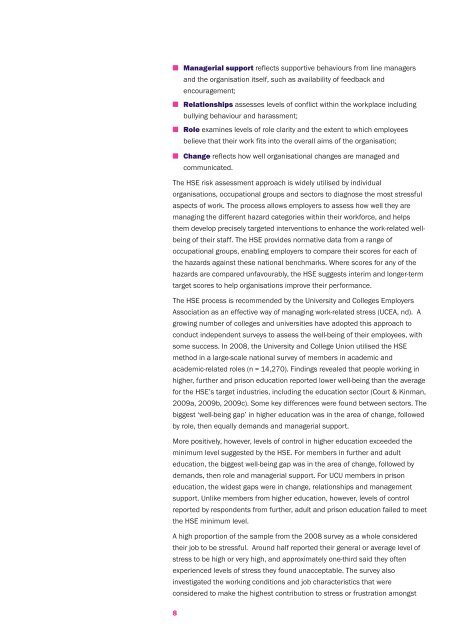
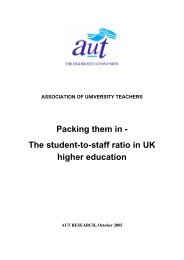
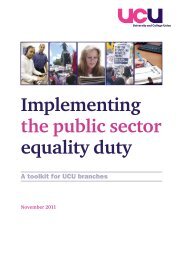

![(.pdf) [29kb] - UCU](https://img.yumpu.com/50914942/1/184x260/pdf-29kb-ucu.jpg?quality=85)







